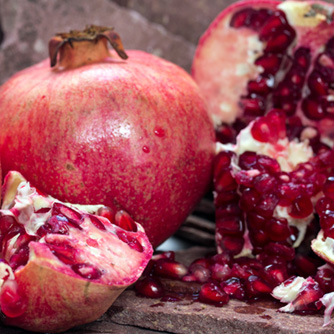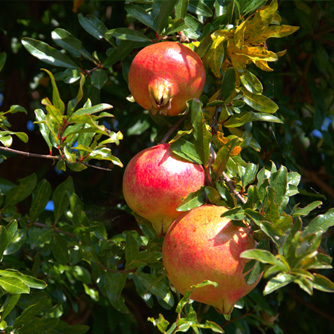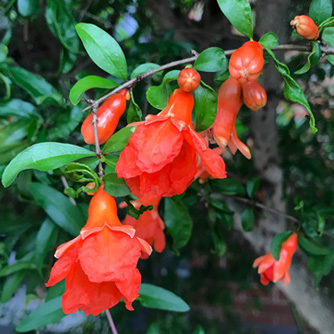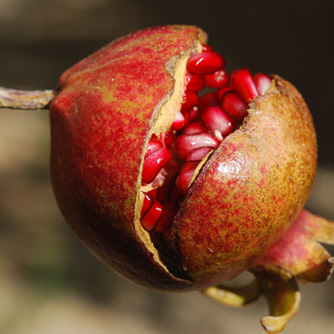Pomegranates
BackPomegranate (Punica granatum) is an ancient fruit tree native to the Middle East that has experienced a surge in popularity in the past few years. Fruit can be eaten directly, juiced or added to dishes. Impress your friends and turn a basic salad into a snazzy dish by including some of the juicy red seeds or try a drizzle of pomegranate molasses as a dressing. Delicious!
Frost and drought tolerant, they are hardy deciduous or semi-deciduous plants that perform well in all regions of Australia. With their lovely orange crepe flowers, yellow autumnal leaves and ripening fruit that hang like lanterns they add interest to a garden all year round!
How To Grow Pomegranates
Pomegranates are versatile plants that can be grown as a small tree, shrub or hedge. They can be espaliered, kept in large pots or even turned into a bonsai if you’re feeling creative. Their main requirements are full sun and excellent drainage.
Pomegranates thrive in hot, dry summers but are surprisingly adaptable to other conditions including the tropics. If grown in very cold regions choose a spot near a north facing wall which will radiate extra warmth and extend their growing season.

Juicy ripe pomegranates
Although they can handle poor soils they will perform better with manure or compost added at planting and then being mulched. Use gypsum to improve drainage if planting into clay soils. Once planted, try not to dig around the base of the tree as disturbing the roots will cause suckers to develop.
Even though they are drought tolerant once established, adequate moisture throughout the growing season will produce sweeter and better quality fruit. Give young trees a dose of OCP eco-seaweed and OCP eco-aminogro every 2-3 weeks and your pomegranate will be rocketing out of the ground!
There are quite a few varieties now available including dwarf and ornamental types so make sure you check the labels before you buy.
Harvesting and Maintenance of Pomegranates
Fruit is picked in autumn when they swell and the skin colours up. Choose the strongest coloured first as fruit will not continue to ripen once picked. Cut fruit from the stem with secateurs without bruising the skin. Ripe fruit on the tree can keep absorbing water and will split if left too long or if you get a burst of rain. Fruit stores for a long time but just remember that it’s the red, fleshy seeds that are edible, not the skin or pulp which should be discarded.

Ripening pomegranates
Pomegranates flower and fruit towards the ends of mature branches. After a few years however a branch will become less productive and should be pruned out to allow younger branches to develop. Only prune a couple of the older branches each year so there’s a mix of branches at different ages to ensure a continued supply of fruit. Pruning is best done in winter. While you’re at it remove any suckers from the base to keep one main trunk. Weak or damaged branches can also be pruned out.
In spring reapply a layer of manure or compost around the base and top up the mulch. Trees can be slow to grow after winter so don’t panic if leaves take a while to form in spring.
Note that it can take around 5-7 years for pomengranates to start fruiting so a bit of patience is required.
Pests and Diseases of Pomegranate
Pomegranates are easy to grow and only suffer a few problems:
- Fruit Fly – even though pomegranates have a thick skin they can still be attacked by fruit flies. Hang the OCP eco-lure trap to keep an eye out for the males and if any appear in the trap then apply a bait spray to kill the females. Alternatively use exclusion netting or bags.
- Mites - occasionally these sapsuckers can be a problem but a few sprays of a horticultural oil will control them.

Vibrant pomegranate flowers
- Splitting Fruit – usually because the fruit has been left too long on the tree or there’s a surge of water just as the fruit ripens (either rain or from your watering). Monitor the fruit as it gets closer to ripening but don’t stress too much as the fruit is still edible even if it splits.

Split pomegranate fruit is still edible


